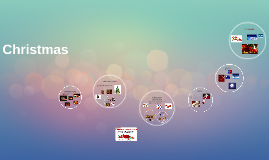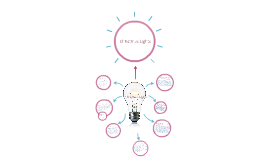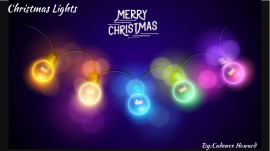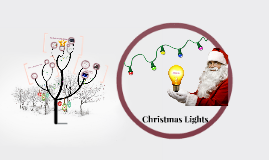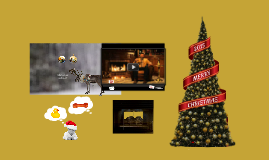Christmas Lights
Transcript: Origin The lights are a reminder for us to be a light to others, as well as representing stars and Christ being the “Light of the World.” In the Christian tradition, candles, and, to a greater extent, Christmas lights, are a symbol for Jesus and the light he brings to earth even in the darkest times. Some believe that the light is symbolic of the eternal light of Jesus’s spirit that is particularly kept in mind over Christmas. Different colored candles also represented different qualities; for example, a white candle represents the purity of Christ, whilst a pink candle represents joy. Before Christmas lights were even invented, people used what was the modern norm for light in their households: fire. The only light used specifically for Christmas was that of the yule log in the fireplace, a tradition that, while not having a specific point of origin, was highly thought to have begun in Germany. The light of the yule log, in addition to providing light and warmth to the household, was a representation of the warm return of the sun come spring. In later years, candles were hung on the Christmas trees- which was a huge fire hazard, but who cared back then- in a similar fashion to today’s lights. Actual Christmas lights were not created until 1880, when they were invented by Thomas Edison. “To display his invention as a means of heightening Yuletide excitement, he strung up incandescent bulbs all around his Menlo Park laboratory compound [PDF], so that passing commuters on the nearby railway could see the Christmas miracle” (Jacob). Two years later, Edward Johnson, a friend of Edison’s, created the first electronically lit Christmas tree. Works Cited Christmas Lights by Noah Clay, Christine Brown, and Cody Hand Every parking spot is filled. Families walk in crowds to get a glance at the famous Bellingrath Gardens Magic Christmas in Lights in Mobile, Alabama. Children hop up and down in excitement at the perspective of seeing a wonderland of brightly colored lights. Parents marvel at the size of the 3 million sparkling lights. With 950 displays and 65 acres to the garden estate, the festively lit light display is a stunning sensation to anyone who views it. Many neighborhoods and stores throughout the country decorate the holiday season with lights just like these,but very few ever wonder how the Christmas lights came to be. The history behind the Christmas lights started out simple, but grew into something miraculous that is used to celebrate the holidays throughout the world in many different shapes, sizes, and colors. Introduction Other Countries Christmas lights are generally similar in appearance: small lightbulbs of various colors strung together on one connecting wire. There are multiple models of these lights, some having all lights of one color, having longer wires than others, or having bulbs of different shapes and sizes. These lights are generally strung on house frames, garden decorations, and Christmas trees, adding holiday flair and creativity to household items. Countries around the world decorate their homes and national monuments with lights. A few examples are the Eiffel Tower in Paris, France and the Sydney Opera House in Sydney, New South Wales, Australia and The London Eye in South Bank of the River Thames in London. Many countries like Spain, Mexico, Britain, Ireland, and America use electric Christmas lights. While other countries like Greenland, Italy, Japan, and Norway use the traditional source of light with candles. Appearance Conclusion The famous December holiday of Christmas is celebrated in many ways, including hanging up lights on houses, gardens, and even trees. These Christmas lights consist of various shapes and sizes. While the lights have a great appearance, they include symbolism varying from being a light to others to the eternal light of Jesus’s spirit. Even different colored lights have their own meanings. People have been using lights as part of the Christmas tradition for longer than the modern-day light was even invented. They used things such as a yule log in the fireplace and candles on the tree. Christmas lights are a large part of Christmas and have many meanings and appearances. Symbolism Jacob, Chris. Christmas Lights, The Brief and Strangely Interesting History Of. Ed. Brian Lam. Kinja, 13 Dec. 2009. Web. 6 Nov. 2014. http://gizmodo.com/5425395/christmas-lights- the-brief-and-strangely-interesting-history-of Lobitz, Robert. Symbols of Christmas: The Story of Christmas Lights. Ed. Robert Lobitz. SayWhyDoI, 16 May 2012. Web. 6 Nov. 2014. http://www.saywhydoi.com/symbols-of- christmas-the-story-of-christmas-lights/ Francis, Zachary T. Christmas Symbols and Their Meanings. Ed. Zachary T. Taylor. KingdomDesignMinistry, 2 Nov. 2006. Web. 6 Nov. 2014. http://www.achristmastestimony. kingdomdesignministry.com/christmas-symbols-and-their-meanings







